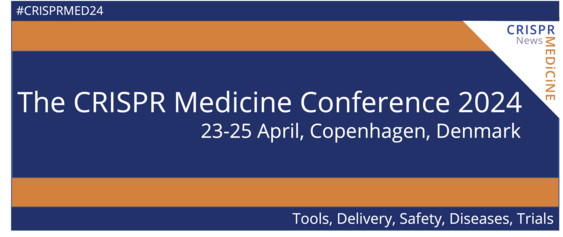CMN Weekly (6 October 2023) - Your Weekly CRISPR Medicine News
By: Karen O'Hanlon Cohrt - Oct. 6, 2023
Top picks
- Scientists at various institutes in the US and South Korea present a protocol that can help to prevent chromosome loss during gene editing. Using single-cell analysis to look at chromosome loss after CRISPR-Cas9 editing with a broad range of gRNAs, the team found that chromosomal loss happens at a low rate across all potential genomic targets and chromosomes, in experimental as well as clinical samples. In collaboration with Carl June at the University of Pennsylvania and the Parker Institute for Cancer Immunotherapy and Howard Chang of Stanford, the team put forward their findings and propose a modified cell manufacturing protocol that can help to mitigate chromosome loss. Their findings were published this week in Cell.
Research
- In an article published this week in Cell, scientists in Japan, Canada and Lithuania report the development of an approach that combines deep mutational scanning and structure-informed design to generate two AsCas12f activity-enhanced (enAsCas12f) variants. The researchers found that the enAsCas12f variants exhibited genome-editing activities in human cells comparable with those of SpCas9 and AsCas12a. Cryoelectron microscopy structures revealed that the mutations stabilise dimer formation and reinforce interactions with nucleic acids to enhance the DNA cleavage activities of the new variants, and enAsCas12f packaged with partner genes in an all-in-one AAV vector demonstrated efficient knock-in/knock-out activities and transcriptional activation in mice.
- Recognising the need for spatial and temporal control of Cas9/dCas9 activity, researchers in Korea report a conditionally active CRISPR-Cas9 system that regulates target gene expression upon sensing cellular environmental change. The team conjugated the oxygen-sensing transcription activation domain (TAD) of hypoxia-inducing factor (HIF-1α) with the Cas9-dCas9 protein. They found that the resulting Cas9-TAD conjugate significantly increased endogenous target gene cleavage under hypoxic conditions compared with that under normoxic conditions, whereas the dCas9-TAD conjugate upregulated endogenous gene transcription. Their findings were published yesterday in Scientific Reports.
- In an article published this week in Nature Communications, scientist at various institutions in the US, Canada and Switzerland demonstrate that SpRYc, an engineered chimeric Cas nuclease that combines the PAM-interacting domain of SpRY with the N-terminus of Sc + +, leverages properties of both enzymes to specifically edit diverse PAMs and disease-related loci for potential therapeutic applications. The authors argue that the approaches taken to generate SpRYc, coupled with its robust flexibility, highlight the power of integrative protein design for Cas9 engineering and motivate downstream editing applications that require precise genomic positioning.
- A team of researchers in Switzerland, Germany and the US demonstrate that epitope-engineered haematopoietic stem and progenitor cells (HSPCs) were shielded from CD123-targeted immunotherapy but remained functional, while CD123-deficient HSPCs displayed a competitive disadvantage. They propose that transplantation of genome-edited HSPCs could enable tumour-selective targeted immunotherapy while rebuilding a fully functional haematopoietic system. Their findings were recently published in Journal of Experimental Medicine.
- Scientists at University of Chicago have developed a statistical method for single-cell CRISPR screening data, called guided sparse factor analysis (GSFA). GSFA infers latent factors that represent coregulated genes or gene modules; by borrowing information from these factors, it infers the effects of genetic perturbations on individual genes. The team demonstrate through extensive simulation studies that GSFA detects perturbation effects with much higher power than state-of-the-art methods. Using single-cell CRISPR data from human CD8+ T cells and neural progenitor cells, they also show that GSFA identified biologically-relevant gene modules and specific genes affected by CRISPR perturbations, many of which were missed by existing methods. Their findings were published last week in Nature Methods.
Industry
- Earlier this week, Intellia Therapeutics and Regeneron announced an expanded research collaboration to develop CRISPR-based therapies for the treatment of neurological and muscular diseases. The collaboration combines Intellia’s genome-editing platform, including its proprietary Nme2Cas9 technology, with Regeneron’s proprietary antibody-targeted AAV delivery technologies to jointly advance in vivo programmes outside of the liver for undisclosed neurological and muscular diseases.
- UK-based gene-silencing technology company Laverock Therapeutics annnounced that it has secured £13.5 million in a seed funding round. The company was founded in 2021 to exploit the potential of its gene-editing induced gene-silencing (GEiGS) technology to develop novel human therapies. The platform is designed to facilitate the creation of therapies that are both programmable and adaptive, with functionality that responds to both intra- and extra-cellular cues. GEiGS works by employing universal gene-editing tools to make minimal adjustments to non-coding genes, redirecting their silencing capabilities toward a new target gene.
Detection
- In an article published yesterday in Lab on a Chip, scientists in China report a new amplification-free assay that can detect telomerase activity at the single-cell level via Cas12a-lighting-up single microbeads. Telomerase activity is widely upregulated in cancer, thus it has been considered a universal biomarker for cancer. In their setup, single-strand DNA reporter (ssDNA reporter)-functionalised single-microbeads (functionalised-SMBs) are employed as a reactor for the trans-cleavage of telomerase-activated CRISPR-Cas12a as well as a reporting unit for fluorescence signal enrichment and visualisation. They demonstrate that Cas12a-LSMBs can accurately detect telomerase activity in crude cell lysates and that they represent a reliable and practical tool to detect telomerase activity in single cells.
- A team in Japan reports a solid-phase collateral cleavage (SPCC) reaction by CRISPR-Cas12 and its application toward one-pot multiplex dsDNA detection with minimal operational steps. The assays works as follows: Cas12-crRNA and single-stranded DNA (ssDNA) are immobilised on a sensing surface, and act as enzyme and reporter substrates, respectively. The team also report a dual-target dsDNA sensor prepared by immobilising Cas12-crRNA and a fluorophore-labeled ssDNA reporter on separate spots. They demonstrate that when a spot captures a target dsDNA sequence, it cleaves the ssDNA reporter on the same spot and reduces its fluorescence by 42.1-57.3%, and that spots targeting different sequences do not show a reduction in fluorescence, thus confirming the one-pot multiplex dsDNA detection by SPCC. Their findings were published this week in Bioconjugate Chemistry.
Reviews
- CRISPR-Cas9 Direct Fusions for Improved Genome Editing via Enhanced Homologous Recombination. In this article, authors in Australia review the ways in which the fusion of CRISPR-Cas9 to functional domains of proteins that directly or indirectly impact DNA repair processes can enhance genome editing.
- Genome and transcriptome engineering by compact and versatile CRISPR-Cas systems. The author of this review provides an overview of recently-developed minitature Cas enzymes that may be attractive for generating CRISPR-based therapeutic approaches that can overcome in vivo delivery constraints. The author argues that these compact Cas enzymes provide a promising opportunity for editing pathogenic mutations of clinical relevance and knocking down RNAs in human cells without inducing chromosomal insertions or genome alterations.
- Innovative Strategies of Reprogramming Immune System Cells by Targeting CRISPR/Cas9-Based Genome-Editing Tools: A New Era of Cancer Management. In this review, authors in Saudi Arabia elaborate upon recent advances in cancer management through immunotherapy in combination with CRISPR-Cas9 technology. They also discuss innovative methods that involve targeting and reprogramming immune cells using gene-editing technology. Future prospects and clinical trials are also discussed.
- Base editing of organellar DNA with programmable deaminases. This review presents the programmable deaminases developed for base editing of organellar DNA in vitro and discusses mitochondrial DNA editing in animals and plastid genome (plastome) editing in plants. The authors also discuss precision and efficiency limitations of these tools and propose improvements for therapeutic, agricultural and environmental applications.
- Engineered mesoporous silica nanoparticles, new insight nanoplatforms into effective cancer gene therapy. This review covers studies about siRNA, miRNA, shRNA, lncRNA and CRISPR-Cas9 delivery by mesoporous silica nanoparticles (MSNs) and proposes that engineered MSNs are a safe and efficient system for gene transfer to cancer cells and cancer mouse models.
Conferences and meetings
- CRISPR Uncut is holding a virutal event 'CRISPR CAREER VIRTUAL EXPLORATION WEEK' from the 18th-20th October 2023. This event is aimed at scientists beginning their career in the CRISPR field, and will provide opportunities to connect with leading experts, explore cutting-edge technology, and find ways to navigate to a exciting career. Register to attend the free event here.
Commentaries
- Discontinued CRISPR gene therapy for sickle-cell disease improves symptoms. Nature Medicine explores the latest translation and clinical research news, with results from a clinical trial of Novartis' discontinued gene therapy to restore foetal haemoglobin.
- Saving lives with xenotransplantation: how biotechs are solving the transplant shortage crisis. This in-depth piece in Labiotech.eu addresses the important question about whether genetically-modified animal organs might aid in solving the global organ shortage crisis. The author provides a status update on organ transplant statistics, and discusses past and emerging solutions based on xenotransplantation, in this case of an animal organ (e.g., a pig) into a human.
News from CRISPR Medicine News
- In this week's clinical trial update, we present an overview of the ongoing clinical trials involving base-editing therapeutic candidates. This article includes trials sponsored by Beam Therapeutics, Verve Therapeutics, and Great Ormond Street Hospital for Children NHS Foundation Trust (UK). Read the update here.
To get more of the CRISPR Medicine News delivered to your inbox, sign up to the free weekly CMN Newsletter here.
Tags
ArticleMissing linksNewsCMN WeeklyIntellia Therapeutics, Inc.Regeneron Pharmaceuticals, Inc.
CLINICAL TRIALS
Sickle Cell Disease, SCD, and Transfusion Dependent Beta-Thalassemia, TDT, (NCT06363760)
Sponsors:
Editas Medicine, Inc.
Sponsors:
Editas Medicine, Inc.
IND Enabling
Phase I
Phase II
Phase III
IND Enabling
Phase I
Phase II
Phase III
IND Enabling
Phase I
Phase II
Phase III







